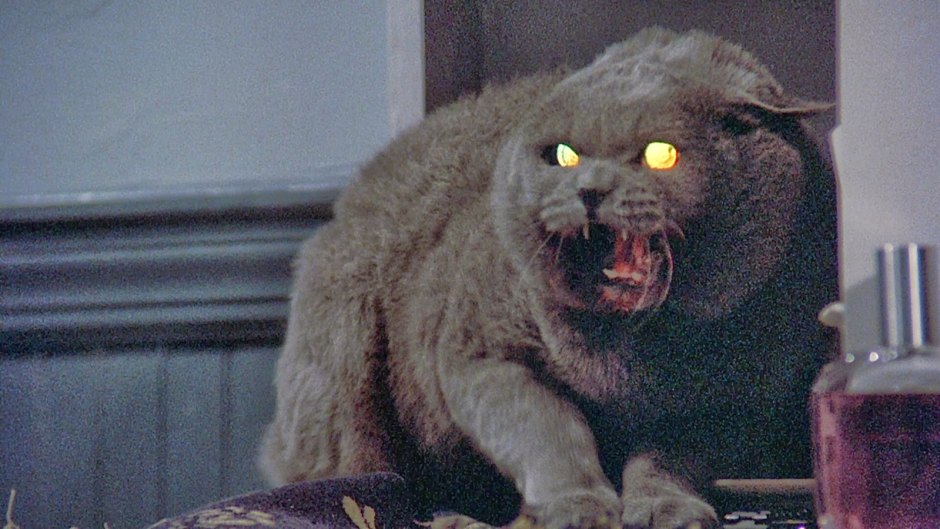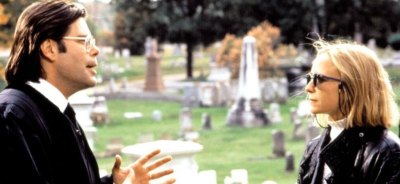
Paramount Pictures
Are You Ready to Revisit the Original ‘Pet Sematary’ For Its 30th Anniversary? Take an Inside Look (Exclusive)
Whether you’ve imagined — or worse — gone through the loss of a child or a beloved pet, how far would you go to have them back in your arms? That is the question at the heart of Stephen King‘s bestselling novel Pet Sematary and the central theme of, now, two films based on it, the first released 30 years ago — and now available on 4K Ultra HD and Blu-Ray — and the second currently in theaters.
The premise has Dr. Louis Creed (Dale Midkiff) moving his family to Maine, where he meets a friendly local named Jud Crandall (Fred Gwynne, best known as Herman on The Munsters). After the Creeds’ cat is accidentally killed, Jud advises Louis to bury it in the ground near the old pet cemetery (misspelled “sematary” in the film). The cat returns to life, its personality changed for the worse. When Louis’ son, Gage (Miko Hughes), dies tragically, Louis decides to bury the boy’s body in the same ground despite the warnings of Jud and Louis’ visions of a deceased patient. Jud’s ominous advice turn out to be true: Sometimes dead is better.
Directing the original Pet Sematary is Mary Lambert who got her start in music videos for such artists as Chris Isaak, Annie Lennox, Mick Jagger, The Go-Go’s, Whitney Houston, Sting, Debbie Harry and Madonna. She took on her first film with 1987’s Siesta, starring Jodie Foster and Ellen Barkin. Next up was Pet Sematary.

Mary describes herself as a “huge” King fan who had read all of his major books at the time, among them The Shining and The Stand. At the same time, she didn’t see herself as a “horror director” back then, though she always had a fascination for the genre as well as the supernatural, fairy tales, science fiction and anything that featured a “weird” angle on reality.
“That was attractive to me from the time I was about four,” she relates with a laugh. “When they sent me the script for Pet Sematary and I read it, I was struck by how, in a certain way, it was similar to this movie I’d just done, Siesta. That was about obsession; about a stunt woman who is so obsessed with the man she’s in love with that she can’t leave — even after she’s died in a tragic accident. Her spirit can’t leave the earthly plane, because of this unhealthy obsession with this man she can’t be with in life, because he’s married to somebody else. So in a way this was the same kind of idea of being so obsessed with a deceased loved one that it leads to bad things, which is summed up by those three words: ‘Dead is better.’ That sums the whole premise up better than I could in a thousand words. But that’s Stephen King’s talent: reaching out and integrating existential themes of mortality and human behavior, and reduce them to a story that has popular appeal that people can absorb.”

It’s her feeling that the power of Pet Sematary comes from the way that it takes a family story of emotion, attachment and love down its darkest path. “Everybody has that fear that someone they love is going to die,” Mary explains. “Whether it’s a child — just one of the most horrible fears a parent could have — or your husband or lover … everybody lives with that fear every day. But dealing with the death of a child caused a lot of people to shy away from the film. There were some actors we talked to that were afraid of it. At the time, I was not a mother, so it was a little easier for me. I think it would have been more difficult for me after my son was born, but it definitely did break some taboos when you’re talking about the death and resurrection of a child.”

“At the same time,” she continues, “traditionally filmmakers deal with taboo subjects that the more conventional or aristocratic genres aren’t allowed to really deal with. Death is one of them. This is one of the first movies that really dealt with that. Then it became kind of a trope for horror movies to begin with a tragedy that drives the plot. But it didn’t really exist before Pet Sematary came to the screen.”
The most powerful moment that occurs in the film is when young Gage wanders onto the road and is struck and killed by a truck which, as Mary explains it, was something that King — to a certain degree — tapped into from his own life. “He tells me that he lived that moment, or close to it,” she details. “He has a family and they live in Maine. He had a young son, they were having a picnic and the boy toddled towards the road — he got there in time, but he said that in that moment of running to get his son and seeing the truck coming, that whole book flashed into his head.”

Speaking of King, usually when a director joins a project they will bring their own writer, but contractually the author was guaranteed to serve as the screenwriter of the film version. “I was thrilled to have him,” she admits. “As I said before, I was already an avid fan and I got to meet and work with somebody whose work as an artist, as far as I’m concerned, makes him the Charles Dickens of our age. In any case, I completely respected his material and didn’t want to change the book into something it wasn’t.”

Fans may want to check out the 4K and Blu-ray release, which features a number of new extras — including the cast and crew of the new Pet Sematary adaptation discussing the original film’s impact and the lasting legacy of its story; a new interview with Mary Lambert about her memories making the film, the restoration, and King’s enduring influence; plus, new photo galleries with behind-the-scenes images, original storyboards and vintage ads. Both discs feature access to a Digital copy of the film and previously released bonus material, including commentary by Mary, a guided tour of the locations led by King along with an exploration of the origins of the novel, an introduction to the cast and characters, and a behind-the-scenes look at the making of the film.








































